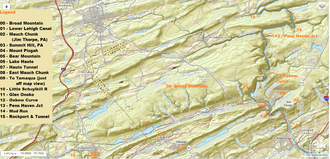Lausanne Landing, Pennsylvania facts for kids

Lausanne, alternately named Lausanne Landing of the 1790s–1820s was a small settlement at the mouth of Nesquehoning Creek on the Lehigh River in marshy delta-like flood plain. Some historic references will mention the presence of a 'Landing Tavern' as the entirety of the town. Lausanne township was originally organized out of dense wilderness along an ancient Amerindian Trail, the "Warriors' Path" an important regional route as it connected the Susquehanna River settlements of the lower Wyoming Valley to those around Philadelphia. During the American Revolution, this route would become the rough 'Lausanne-Nescopeck Road', and after the turn of the century with a charter (1804), be improved into a toll road, the Lehigh and Susquehanna Turnpike. The fan-shaped plain provided some of the flattest landscape terrain in the entire area, and was able to support a few small farm plots, boat building, and a lumbermill. With nascent industrialization hitting America, widespread local deforestation occurred to feed lumber mills and craft transports. Exacerbating local clearcutting was convenient river access, for the Lehigh could (at least, seasonally with preparation) support river arks. The Nesquehoning Creek mouth issues behind a small river island and sits above the long curved lake-like upper pool of the Lehigh below the outlet of the gorge, and its delta's smoothly sloped sides made an attractive landing beach, giving name to the Inn. With the popularity of the route and the roughness of the country, often called "The Switzerland of America" the location was a natural rest stop for the next leg to the north involved a steep climb and was over nine miles to the area of Beaver Meadows. Hence early on it added 'Landing Tavern' to its nicknames.
At that time, all of Northampton north of the Blue Mountains was known as the Towamensing District, "Towamensing" being an Indian word for "wilderness".
It was used initially by transient work crews timbering and building temporary river boats to haul cargo known as arks, a common solution to ship upstream resources out of the frontier. As such early on it anchored a sawmill, tavern, crude housing, tool and work sheds, and in 1804–05, a toll house built for the Lehigh and Susquehanna turnpike, climbing the nearby ravine of Jean's Run as it began the sharp ascent up Broad Mountain to pass in succession along the banks of the Black Creek, Quakake Creek, Beaver Creek valleys in (the future) Carbon County, Pennsylvania then climb Hazel Creek into Luzerne County up to the flat area of the Mountain pass, a marshy saddle which would become Hazelton, PA near the 1780s settlement of St John's along the descent to Nescopeck on the Susquehanna – PA 93 follows much of the same road bed, save for starting at an elevated altitude from the nearby town of Nesquehoning, PA via a high level bridge.
The Moravians had been following the "Warriors' Path" used by the Delawares and Senecas since 1742, when Count Nicholas Lewis von Zinzendorf, the missionary who founded Bethlehem, used the trail. The path widened as missionaries traveled through what is now Hazleton on their way to Berwick and the Wyoming Valley along the Susquehanna River.
The first step toward developing a town came in 1804 when a private company built the Berwick Turnpike along the old Indian trail in an effort to open a way to the lumber lands along the upper reaches of the Susquehanna.
Images for kids


